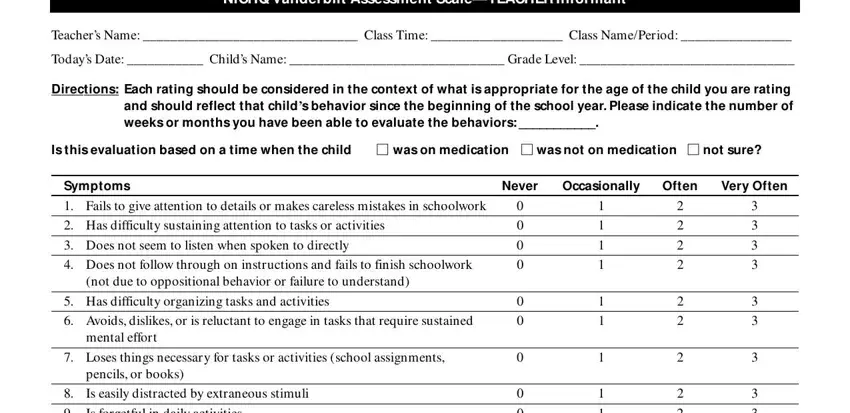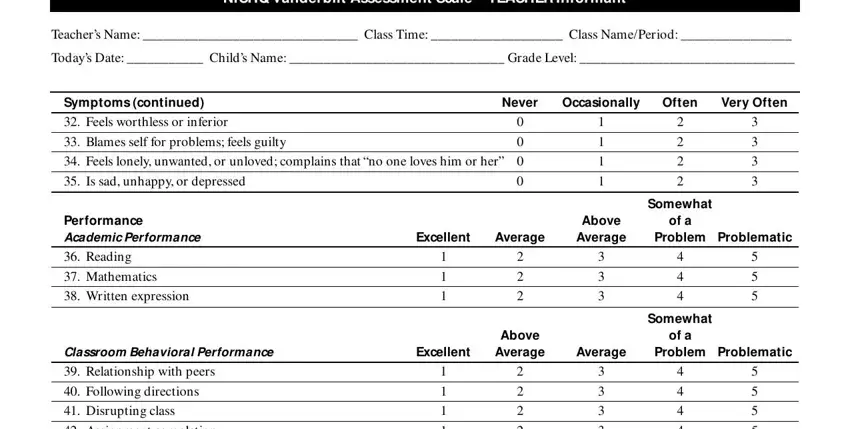You can fill out vanderbilt forms pdf effectively with the help of our online PDF tool. FormsPal team is aimed at providing you the absolute best experience with our tool by consistently presenting new capabilities and enhancements. Our editor is now much more useful as the result of the most recent updates! So now, editing documents is simpler and faster than before. To get started on your journey, go through these basic steps:
Step 1: First, access the pdf editor by pressing the "Get Form Button" in the top section of this site.
Step 2: Once you open the PDF editor, there'll be the form prepared to be filled in. Aside from filling in different blanks, you may as well perform many other things with the file, that is adding custom words, editing the original text, adding images, affixing your signature to the PDF, and much more.
This form will need particular details to be filled in, therefore you should definitely take whatever time to provide what's asked:
1. The vanderbilt forms pdf will require specific details to be inserted. Ensure that the following fields are completed:

2. After filling out the last section, head on to the subsequent step and fill in all required particulars in these fields - Is forgetful in daily activities, Fidgets with hands or feet or, Leaves seat in classroom or in, seated is expected, Runs about or climbs excessively, seated is expected, Has difficulty playing or, Is on the go or often acts as if, Talks excessively, Blurts out answers before, Has difficulty waiting in line, Interrupts or intrudes on others, Loses temper, Actively defies or refuses to, and Is angry or resentful.

Always be really attentive when filling out seated is expected and Fidgets with hands or feet or, because this is the part where a lot of people make some mistakes.
3. Your next stage is generally easy - fill in all of the fields in NICHQ Vanderbilt Assessment, Teachers Name Class Time Class, Todays Date Childs Name Grade, Symptoms continued, Feels worthless or inferior, Blames self for problems feels, Feels lonely unwanted or unloved, Is sad unhappy or depressed, Performance Academic Performance, Reading, Mathematics, Written expression, Classroom Behavioral Performance, Relationship with peers, and Following directions to complete this process.

4. All set to fill in this fourth portion! In this case you've got all of these Assignment completion, Organizational skills, Comments, Please return this form to, Mailing address, Fax number, For Office Use Only, Total number of questions scored, Total number of questions scored, Total Symptom Score for questions, Total number of questions scored, and Total number of questions scored blank fields to complete.

5. This pdf must be completed with this particular area. Below you will notice a comprehensive listing of form fields that require accurate details for your document submission to be complete: Total number of questions scored, Total number of questions scored, and Average Performance Score.

Step 3: After you have looked once again at the information in the fields, press "Done" to complete your form. Right after creating a7-day free trial account with us, it will be possible to download vanderbilt forms pdf or email it promptly. The PDF form will also be easily accessible via your personal account menu with all your adjustments. With FormsPal, it is simple to fill out documents without stressing about information breaches or records getting distributed. Our protected system ensures that your private data is stored safely.



